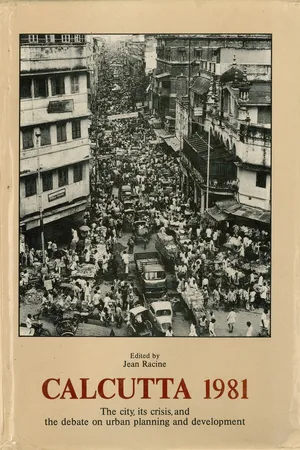
Calcutta 1981
The city, its crisis, and the debate on urban planning and development
- English
- ePUB (mobile friendly)
- Available on iOS & Android
About this book
A city laden with symbolic meaning in the Western mind, Calcutta – with ten million inhabitants today – is much more than the apathetic or violent display of urban destitution in India, as seen by the world at large. This collection tries to reach precisely beyond the cliches, to enable some of those who work in the city as decision-makers, planners or analysts, to speak out and Interpret the multifaceted crisis that has hit this city as it continues to grow, even though its economy is in decline. Their words have all the force as they are derived from first-hand experience. In analysing the laboured evolution of this city, once known as "the most beautiful city east of Suez", we have provided some material on a major case-study for the debate on urban planning and development in the Third World. The planning exercise launched in Calcutta in early 1960s, with support from American experts, hoped also to halt the spread of communism in Bengal. This was a vain expectation, however, as the Communist Party of India-Marxist has been continuously voted into power since 1977. From that date, the Left Front Government has controlled the Calcutta Metropolitan Development Authority, which provides amenities to the city and metropolitan district with support from, among others, the World Bank. What are henceforth the urban development policies of "parliamentary communism"? What are the problems they are up against when action is necessary on all fronts at once? In the final analysis, for what purpose and for whom are they planning? What should be the priorities? To set up the economy to right first? To provide amenities for the city? Or to improve the daily life of the most underprivileged? When confronted with these realities, what the Left is able to achieve in power? These are some of the questions that the contributors to this collection have, in their own way, been concerned with in creating an image of present-day Calcutta, seen through its own eyes.
Frequently asked questions
- Essential is ideal for learners and professionals who enjoy exploring a wide range of subjects. Access the Essential Library with 800,000+ trusted titles and best-sellers across business, personal growth, and the humanities. Includes unlimited reading time and Standard Read Aloud voice.
- Complete: Perfect for advanced learners and researchers needing full, unrestricted access. Unlock 1.4M+ books across hundreds of subjects, including academic and specialized titles. The Complete Plan also includes advanced features like Premium Read Aloud and Research Assistant.
Please note we cannot support devices running on iOS 13 and Android 7 or earlier. Learn more about using the app.
Information
Table of contents
- Cover
- Bibliographic informations
- First pages
- Notes
- Table of contents
- Dedicace
- List of tables
- List of maps and charts
- List of plates
- Acknowledgements
- The Seminar Participants
- Foreword. The Seminar and After
- Introduction. Narcissus' Doubts
- Inaugural Session
- Session I. A. The Foundations of the Present: Understanding Calcutta
- Session I. B. The Foundations of the Present: Understanding Calcutta
- Session 2. A. A Metropolis in Crisis
- Session II. B. A Metropolis in Crisis
- Session III. A. Tackling the Crisis
- Session III. B. Tackling the Crisis
- Session IV. General Debate
- Bibliographies, Filmography
- Index
- Reference Maps